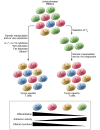Selection bias: maintaining less-differentiated T cells for adoptive immunotherapy
- PMID: 26657855
- PMCID: PMC4701555
- DOI: 10.1172/JCI85631
Selection bias: maintaining less-differentiated T cells for adoptive immunotherapy
Abstract
The clinical application of T cell immunotherapy depends on ex vivo modification and expansion of T cells for adoptive transfer. In preclinical models, the use of a purified, naive T cell subset enhances persistence and antitumor immunity; however, the majority of clinical studies rely on modification of mixed populations of T cells that contain only a small subset of highly functional T cells with less-differentiated phenotype. In this month's issue of the JCI, Klebanoff and colleagues uncover a Fas-mediated interaction between naive T cells and antigen-experienced T cells that drives differentiation and impairs adoptive immunotherapy. Further, they show that blockade of Fas signaling enhances antitumor immunity and increases survival in a mouse model of melanoma. Their work supports a growing body of evidence that the use of naive T cells enhances the efficacy of adoptive T cell therapy and suggests a new therapeutic strategy for preserving less-differentiated T cell populations.
Figures

Comment on
-
Memory T cell-driven differentiation of naive cells impairs adoptive immunotherapy.J Clin Invest. 2016 Jan;126(1):318-34. doi: 10.1172/JCI81217. Epub 2015 Dec 14. J Clin Invest. 2016. PMID: 26657860 Free PMC article.
References
Publication types
MeSH terms
LinkOut - more resources
Full Text Sources
Other Literature Sources
Research Materials
Miscellaneous

